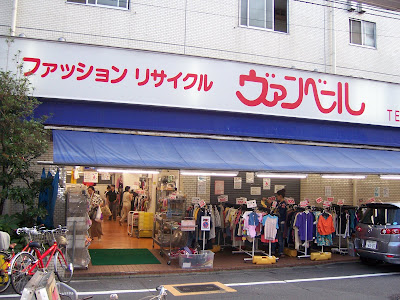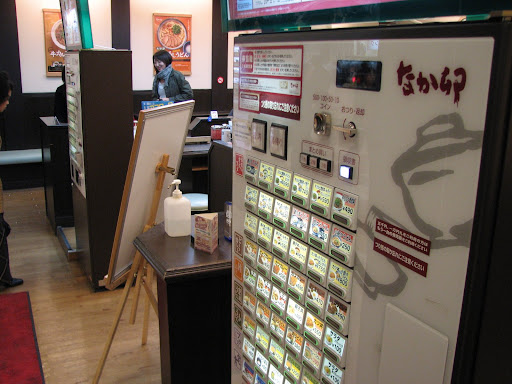Someone emailed me recently asking for advice on how to live on a budget in Tokyo. Perfect timing! I’ve actually been brain-storming ways to cut back costs in the last few weeks, being that I’m perpetually broke and soon to be unemployed.
In general, I’m not one to give advice on anything, let alone saving money. I’m the girl who’s never seen without a 500 yen cup of Starbucks in hand and who has taken a 7,000 yen cab ride home from a club not once or twice, but five times in the last six months.
I guess that’s what happens when you treat a stint teaching in Japan like a jail sentence. You end up discovering new and more expensive ways to make yourself feel better. I worked hard for this 1,800 yen movie ticket. I deserve this 1,200 yen hamburger. And then before you know it, you find yourself surviving off of 100 yen shop ramen for six days straight while you wait for your next paycheck to get deposited.
Yeah, that’s pretty much my life.
So for an awesome ‘How-to’ guide on surviving Tokyo, check out the blog Tokyo Survival Tips. I wish I’d discovered her site sooner, say, when I first moved here! I had to learn everything the hard way, completely on my own.
But I have mentally stashed away a few tips and tidbits of advice over the last few months. Little mental notes stored away for whenever the time came when I found myself broke and jobless, (I.e., last December and next week Thursday).
Shop in Thrift Stores

 Fashion Recycle, Nishikasai
Fashion Recycle, NishikasaiThe pictures above are ones I took of a thrift store in Nishi-Kasai (Tozai line). Look at those racks of 100 yen clothing! Everything outside was only 100 yen, and there were a few racks inside as well. I’ve been back to that shop a couple of times now, and the 100 yen racks and bins are always there, so it wasn’t just a fluke ‘one day’ sale.
There are a lot of thrift stores in this city. Harajuku is known for them and two of my favorites are Chicago (best quality) and Kinji (biggest selection, cheapest) but I find that for the best prices, it’s better to explore outside of downtown Tokyo.
Thrift stores/ Used clothing stores/ Second-hand shops in Tokyo aren’t your grandmother’s Savers or Goodwill, because the clothing is stylish and in excellent condition. I don’t know if it’s because most Japanese people air dry their clothing versus machine dry or if it’s because they replace their last seasons pieces with newer, trendier ones at a higher rate than in the States, but most of the clothing in these ‘used clothing stores’ look almost brand new. There are no holes, missing buttons, broken zippers or faded colors.
Switch from Coffee to Tea
I love coffee and used to drink three or four cups a day, so this one was tough. But I made the decision to switch because not only is it healthier, it’s a helluva lot cheaper.
Never mind Starbucks, even buying ground coffee beans in the grocery store can set you back 700 yen. But you can buy 25 tea bags at the grocery store for only 300 yen, which is a third of the price of that equivalent in coffee.
A good place to taste-test teas (if you’re a Tea Newbie) is the Japanese equivalent of a diner, (Jonathan’s, for example). They have decently-priced lunch and dinner specials (500-800 yen) and for 200 yen you can purchase an all-you-can-drink “drink bar”. In addition to all-you-can drink coffee, lattes, espressos, hot chocolate and sodas, they have a wide-variety of flavored teas.
Tip for the caffeine-addicted: black tea has the most caffeine!
If you’re really craving a cup of coffee, then McDonalds sells 120 yen iced or hot coffees (small) and 220 yen medium sized cups of coffee. Note: A medium in Japan sizes would be a small by US standards.
Eat at Ticket Machine Restaurants

I’m obsessed with these restaurants. You can usually find them most anywhere, especially in or around train or subway stations. It’s great a place to go if you don’t speak or read Japanese because you place your food order by depositing money into a vending machine and not with a waiter or waitress.
A plate of beef curry and rice only costs 350 yen, and ditto for a bowl of rice and beef. All of the meals come with a cup of miso soup as well as a cup of tea. It’s a healthier (and cheaper!) alternative to American fast food.
Watch TV Shows and Movies Online…Instead of Renting
A co-worker told me about Watchtvsitcoms.com a couple of weeks ago and I’ve been spending all of the time I’d set aside for studying Japanese, catching up on episodes of Entourage and The Office.
The site has a wide-selection of shows and movies and you can view them legally and for free. You don’t have to (and can’t) download any of them, but the site might try to encourage you to download some software or pay a monthly rate – Just hit the ‘No Thanks’ button.
Learn How to Cook Japanese Food!
I think that my biggest money saver has been to stop trying to cook Western food and incorporate more Japanese food into my diet. A lot of what I knew how to cook involved an oven or an ingredient that I couldn’t readily buy from the local grocery store. And spending 2,000 yen on sour cream and salsa at an International store just to make a small plate of nachos, wasn’t worth it, ‘comfort food’ or not. Besides, have you ever noticed how many American / European dishes call for meat as a staple ingredient? Steak and mashed potatoes. Meat Loaf. Baked Chicken casserole. Meat is expensive here!
Stir fry, however, is not. Vegetables like mushrooms, spinach, onions, carrots and cabbage are really reasonably priced and frequently on sale, often for as little as 10 yen each. The Japanese packages of curry mix are usually around 150 yen and that’s enough for four or five meals.
Okonomiyaki is econonomical…and it tastes good too! Rather than try to explain what it is, here’s a video on how to make it. It features some foo foo dog and a voice-over by some guy with a strange (french?) accent. Funny.



Such great advice. I’m adjusting to living in Paris and am always looking for new ways to save cash. These tips, I think, can be applied to a lot of different cultures easily. Thanks for the help.
Hi Kevin,
Paris one of my favorite cities in the World…but I guess most people say that now don’t they? You’re very lucky to live there. Is it really expensive at the moment?
You can also watch US TV shows (and some movies) for free on hulu.com (at least you can from the US)
hey there Reannon! i also recommend http://greatstufftv.com/ and http://www.surfthechannel.com .. you`ll never have to rent another dvd again!
Thanks guys,
I’ll check those sites out! It’s tough finding ones that allow you watch them in Japan…most of the sites I’ve looked into only work in North America…but thanks for the tips!
nice post…….
Everyone can save money in small and seemingly insignificant areas if you know how and where to do it.
this reminds me of my time in Germany as a graduate student(read as “broke bum living like off peanuts”).. despite the penury I still managed to have a enormous amount of fun.. I guess thats because when you are broke you always come up with strange ideas to save money.. and end up having strange experiences as well.. know what I am saying? 🙂
Help! I am trying to buy a gift certificate for somewhere in Tokyo for a friend’s one year old and can’t find anything online. Can you help? I am in the US. Love the blog by the way.
Hi SMG…Hmmm…I’ll have to think about that one! I don’t have any kids and don’t shop for them…so that’s a tough one. I’ll think about it and get back to you though!
It’s actually not as bad as I thought it would be. The lower exchange rate is helping out some too. You just have to limit your activities and look for those off beat places to avoid paying “touristy” prices for everything.
Nice post
A budget is a spending plan that includes everything you will spend money on. A good budget is a spending plan that includes everything you will spend money on and stays within your income.
Budgeting tips, information, advice, and resources to help you set up a successful budget and stay motivated.
Despite Harajuku is more known, I think the best places to buy second hand clothes are Koenji and Shimokitazawa. Both neighborhoods are known for their underground culture and they are quite popular among college students (who usually are broken). Not only clothes, but there are a lot of second hand books and records shops in both places.
Another advise is to look for things in flea markets. Tokyo have a few of them, usually once per month in each spot. There you can find stuffs like records, books, clothes, some houseware, etc.
New in the town and need some furniture and houseware? In second hand shops (中古屋- chukoya), you can find a dressers, vacuum cleaners, suihankis (rice cooker) , microwaves, etc. And in the 100 yen shops (百金 or 百円ショップ), you can buy (almost) all houseware you need and despite cheap, the quality and design in quite impressive (I used to be a hyakkin addicted).
About food: cooking is good. And that way you can have 3 meals per day spending less than 500 yens per day. The best time time to go shopping is around 6 pm. That’s when groceries start to drop the prices. And at the supermarkets bread go on sales too. I used to buy 3 or 4 packs and put all in the freezer. And from there to the toster. And make obento (lunch box). Everyday I made obento as my lunch at school. Don’t like cold food? Try to find a microwave. At my school, there was a lounge with a microwave to heat the lunch and I notice there are microwaves in some art and sport clubs.
And finally, start a relationship with your neighborhood shops. Time to time you can get some omake (discount), even extras in you buy something. Once a get a free pack of shiitakes in my grocery shop after buying some vegetables.
Hold on, what about:
Don’t buy:
– a 500 yen cup of Starbucks
– a 7,000 yen cab ride home for five times in the last six months,
– a 1,800 yen movie ticket,
– a 1,200 yen hamburger.
How about that?
At current exchange rates, I think you just have to avoid Tokyo (and Japan). Basically, everything is 50% more expensive in USD than it was 4-5 years ago.